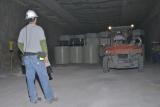Nuclear Weapons Production Waste
Radiation Facts
- The creation of nuclear weapons produced a large amount of waste, which is still being managed today.
- Plutonium levels in the environment are very low and pose little risk to most people.
When the Cold War ended in the late 1980s, the United States, and much of the rest of the world, stopped making and testing new nuclear weapons. Since then, the U.S. has focused on maintaining existing warheads and is in the process of disposing of the radioactive waste left behind.
About Nuclear Weapons Production Waste
Plutonium and uranium were used to create fuel for nuclear weapons. When nuclear bombs detonate, atoms split and release enormous amounts of energy through a nuclear reaction. Between 1944 and 1988, the United States built special reactors to make about 100 metric tons of plutonium for nuclear weapons. The reactors created the highly radioactive plutonium by bombarding uranium fuel rods with neutrons. Each time a uranium atom changed to a plutonium atom, more neutrons were released, causing a chain reaction. The process continued until the majority of the uranium atoms were converted to plutonium, thus ending the chain reaction. At this point, the fuel rods are said to be spent (used up) and they were removed from the reactor.
Workers used strong acids to dissolve the plutonium from the fuel rods. This process left behind more than 100 million gallons of hazardous liquid waste. It is called mixed waste because it contains both hazardous chemicals and radioactive materials. The Department of Energy is working to safely cleanup and dispose of these nuclear weapons production wastes.
Workers at nuclear weapons production facilities wore protective clothing and worked with a variety of equipment. Clothing, glassware, tools, equipment, soils and sludges became contaminated with radioactive materials. These are called transuranic wastes and are permanently disposed of at the Waste Isolation Pilot Plant (WIPP) in Carlsbad, New Mexico.
What You Can Do
Plutonium levels in the environment are very low. They pose little risk to most people. However, people who live near old weapons production or testing sites may have a higher risk of exposure. You can contact your local facility or visit their website to learn more. You can also contact your state radiation office to get more information about monitoring and safety rules.

